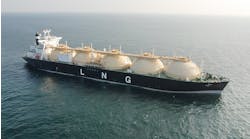BAKU, June 6 -- BP PLC's plans to develop the giant Shah Deniz gas condensate field in the Caspian Sea moved ahead Tuesday with the award to Technip SA of a front end engineering design contract based on the French contractor's TPG 500 production jack-up concept.
BP expects Technip's self-installing fixed platform, already installed on the British major's North Sea Harding field, and, more recently, TotalFinaElf SA's Elgin-Franklin development, to cost in the region of $350 million. A total of 10 wells will be drilled from the platform, which will stand in 100 m of water 80 km off Azerbaijan.
Technip called the contract "strategically important [as it] confirmed the interest of a major oil and gas company for the TPG concept which is perfectly suited for oilfield development in shallow waters, not only in the North Sea but also in remote areas such as the Caspian Sea."
Technip will carry out the FEED study, scheduled for completion by the fourth quarter, at its upstream division's Paris offices.
The Technip deal, one of four contracts announced by BP as part of its $2.6 billion Shah Deniz Stage 1 project, follows last month's award to KCA Drilling Ltd. of a FEED for the construction and commissioning of drilling facilities for the field (OGJ Online, May 1, 2001).
BP spokeswoman Taman Bayatly said the two contractors were working closely during the FEED period.
The contracts for the upstream and midstream concept FEEDs were won by Halliburton Co. unit Brown & Root and Kværner AS, respectively, early last year. Brown & Root is charged with the "overall offshore concept" and Kværner with designing the 26-in. gas and 12-in. condensate pipelines linking the platform to an onshore terminal. Bayatly said Wednesday that basic engineering on both FEEDs was nearing completion, with detailed engineering to follow.
She said subject to governmental, sales, and purchase agreements, BP expects sanctioning of Stage 1 of Shah Deniz by the end of the year. She said construction could start early in 2002.
Production from Shah Deniz would begin in late 2004 and reach 8 billion cu m/year by 2007.


